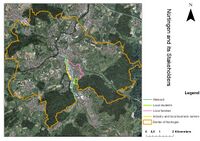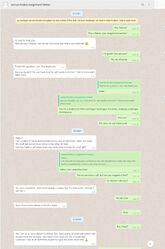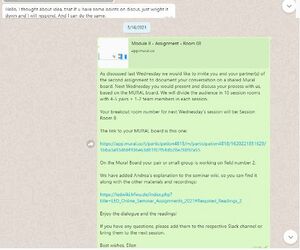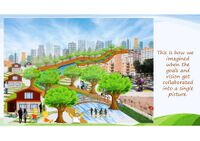LED2LEAP 2021 - Nürtingen Team 1: Difference between revisions
Rehan.wasi (talk | contribs) |
Rehan.wasi (talk | contribs) |
||
| Line 142: | Line 142: | ||
Before coming to that, our problem statement was defined as the absence of community spaces for people to gather around and have a place to spend their leisure time. The lack of open spaces nearby, and the accessibility to the river are one of the major concerns related to the problem. | Before coming to that, our problem statement was defined as the absence of community spaces for people to gather around and have a place to spend their leisure time. The lack of open spaces nearby, and the accessibility to the river are one of the major concerns related to the problem. | ||
The individuals who were working upon it were given a set of tasks to write down the goals separately. Later, similar goals were clubbed together. Now the decision is being made by vote. Each one had 5 votes and could be used as per own wish. Goals were selected on that basis. | The individuals who were working upon it were given a set of tasks to write down the goals separately. Later, similar goals were clubbed together. Now the decision is being made by vote. Each one had 5 votes and could be used as per own wish. Goals were selected on that basis. | ||
Revision as of 17:33, 18 July 2021
>>>back to working groups overview
For help with editing this Wiki page use this link.
For assignments and key readings use this link.
| Area | Steinach and surrounding area | |
| Place | Nürtingen | |
| Country | Germany | |
| Topics | blank | |
| Author(s) | blank, blank, blank, blank, blank | |
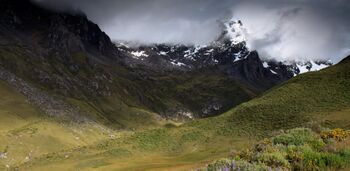
| ||
Landscape Democracy Rationale
Landscape can be seen as a product of society, which is connected to their personal history, according to Berger and Luckmann (1966). "Land", in German, can be seen as a contrast between city and countryside, including meanings such as shape, form, texture, nature, condition and manner. However, in Old High German, the landscape was associated to an object "that has the quality of a larger settlement area in most cases" (Müller, 1977). But a more recent description that fits our current location can best be described as: On's own region or nation is described in terms of its natural and cultural characteristics, so that it becomes socially available as something diametrically opposed to other regions and nations (Lekan and Zeller, 2005).
Location and Scope
- Our focus area is situated at the south-east of Nürtingen. The area surrounds the river Steinach - one of the major tributaries of river Neckar. It has industrial units and settlements are a thread-link to the vicinity of the river.
- The whole stretch of the marked area has different types of communities and stake-holders involved. It gathers people from the neighbourhood, as well as the passerby.
- It is a road which is parallel to the main road. This could help in creating an alternate thoroughfare, which could be much more interesting to step into.
Phase A: Mapping Your Community
Welcome to the Community and their Landscape
The main location is based around the river named Steinach, which is a side river from the Neckar. The Steinach river is currently not in his natural state cause of the densely built environment. So to prevent flooding grass buffers, dams and slopes are currently installed. Except for these grass buffers not much open space can be found here. Most of the parcels connecting the river are privat or used as parking space, missing the opportunity for visitors to walk along the Steinach.
Groups of Actors and Stakeholders in Your Community
- From the spatial character and land use pattern of our study area, we can see different groups of actors and stakeholders. Among the local residents, elderly citizens, kids, land owners and students are considered as important actors of our landscape. As a predominant industrial zone, we have owners, workers and local business persons. We have local clubs and municipality who are more organised actors among the groups. Another significant group we can see in the community are tourists,commuters and investors.
- Children, teenagers and retired and elderly groups are the most visible group in our landscape whereas mid-aged and working class are less visible.
- Depending on the age and social groups, the community has different needs and aspiration.Local residents want to have safety and health as well as interactive spaces.The business group and municipality have aspiration of sustainability and growth from the landscape. Tourists want to have access to attractive spaces with safety and facilities.
Relationships Between Your Actors and Groups
- The stakeholder - those are impacted by the landscape democracy challange and have an role to play have been shown in the power map. Kids and eldery are highly impacted whereas kids have less power.On the other hand,students are more organised group with better power.Local land owners and shop owners,industry owners hold power to influence- making them one of the major stakeholders.Tourists are the group with less power and impact , yet have a significant impact in our study area.Municipality has the most administrative power but likely to be less affected.
Summary of Your Learnings from the Transnational Discussion Panel
When I read about the protest privatization of a public park in Istanbul Turkey in 2013 I was shocked. I never imagined a problem like this would occur in the EU. Because enjoying and experiencing nature is a basic human right, and I never thought it would be possible to take this away from the public. However, this is not the case everywhere because after bringing this up in the discussion panel, other colleges told me they experienced the same situation.
Theory Reflection
The given theory is helpful for a critical start in this project. It gives an overview of the different meanings of the landscape. Which can have a close relationship between science and society. A very interesting statement is for example written in the "Pledge for a transformative science, written by Uwe Schneidewind, Mandy Singer-Brodowski, Karoline Augenstein and Franziska Stelze. Here is described that technological development led to an increased disconnection in society, for example, technological innovations have interfered and are still interfering with the natural and human systems. Resulting in unplanned and often until the point of no return, ecological and social side effects (Beck, 1986). That is why innovation, participation, and balance power are very important in today's society towards the landscape. Which creates the interesting discussion around Landscape democracy.
References
Schneidewind, Uwe et al (2016): Pledge for a Transformative Science - A conceptual framework Kühne, Olaf (2015): Landscape Concepts LED Team (2019):Landscape Education for Democracy
Phase B: Democratic Landscape Analysis and Assessment
Mohit Sehrawat and Ivona Poljak Correspondence
Design as Democracy, chapter Going to the People's Coming, was read by Ivona and I have read literature Community matters. At first of all we got to know each other through email and later on via different social networking sites. At first it felt to be very difficult communicating with Ivona as of our busy schedules but we got time on weekends. The reading part was well discussed within both the topics. Getting to know the community can involve creative scenarios that seem more like play than planning and solved alot of the doubt and question relating to the subjects. It was a wonderful experience to have a tandem partner like Ivona
On photos below you can read in detail the topics we read and discussed about as well as the flow of our conversation.
Abhishek Vekariya and Ahmed Essounni and Tiffany Liu Correspondence Correspondence
Rehan Wasi and Samuel Roskos Correspondence
- REFLECTION
- REFLECTION
- MODE OF INTERACTION
Phase C: Collaborative Visioning and Goal Setting
The Scene in Your Story of Visioning
The periphery area of the River Steinach in Nürtingen was chosen. It is near to the residential settlements and also to the industrial area. The main issue lies in the connection between the neighborhood and the river. The challenges shown in the figure below illustrate these selected problems.
Before coming to that, our problem statement was defined as the absence of community spaces for people to gather around and have a place to spend their leisure time. The lack of open spaces nearby, and the accessibility to the river are one of the major concerns related to the problem.
The individuals who were working upon it were given a set of tasks to write down the goals separately. Later, similar goals were clubbed together. Now the decision is being made by vote. Each one had 5 votes and could be used as per own wish. Goals were selected on that basis.
A vision was created: Recreation of humans, plants, and animals across the river Steinach.
Goals were shortlisted like introducing native species and green buffer in the area to help the biodiversity. Other goals included: Providing spaces to increase the number of activities in parts of different areas. To have steps and spaces to sit closer to the water in Steinach. Change the slope gradient from the road to the river so the river is visible from higher ground. In accordance with it, the Action Plan was developed.
The Actors in Your Story of Visioning
- insert text here
The Story of Visioning
- insert text here
Reflect on Your Story of Visioning
- insert text here
Phase D: Collaborative Design, Transformation and Planning
Your Prototyping Action
- insert text here
The Evolution of Your Prototyping Action
- insert text here
The Plan Behind Your Prototyping Action
- insert text here
The Realization of Your Prototyping Action
- insert text here
Reflect on Your Prototyping Action
- insert text here
Phase E: Collaborative Evaluation and Future Agendas
Collaborative Evaluation and Landscape Democracy Reflection
- insert text here
The Actors in your Collaborative Evaluation
- insert text here
Reflection on the Online Seminar
- insert text here
Reflection on the Living Lab Process
- insert text here
Your Living Lab Code of Conduct
- insert text here
Process Reflection
- insert text here

